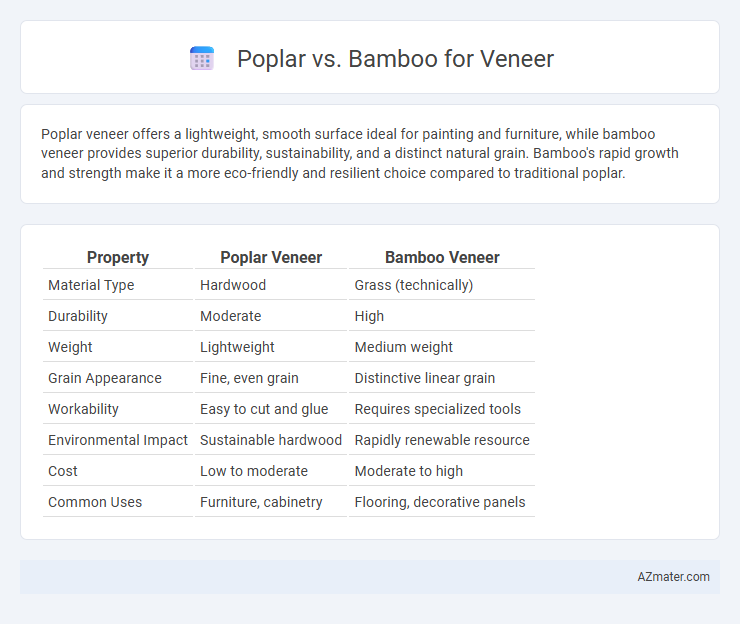Poplar veneer offers a lightweight, smooth surface ideal for painting and furniture, while bamboo veneer provides superior durability, sustainability, and a distinct natural grain. Bamboo's rapid growth and strength make it a more eco-friendly and resilient choice compared to traditional poplar.
Table of Comparison
| Property | Poplar Veneer | Bamboo Veneer |
|---|---|---|
| Material Type | Hardwood | Grass (technically) |
| Durability | Moderate | High |
| Weight | Lightweight | Medium weight |
| Grain Appearance | Fine, even grain | Distinctive linear grain |
| Workability | Easy to cut and glue | Requires specialized tools |
| Environmental Impact | Sustainable hardwood | Rapidly renewable resource |
| Cost | Low to moderate | Moderate to high |
| Common Uses | Furniture, cabinetry | Flooring, decorative panels |
Introduction: Poplar vs Bamboo Veneer
Poplar and bamboo veneers offer distinct advantages for woodworking and furniture design, with poplar known for its lightweight, smooth grain, and easy staining capabilities, making it ideal for painted finishes and fine cabinetry. Bamboo veneer stands out for its exceptional sustainability, rapid growth cycle, and natural strength, providing a durable and eco-friendly alternative with a unique, modern aesthetic. Choosing between poplar and bamboo veneers largely depends on desired appearance, environmental impact, and project durability requirements.
Overview of Poplar Veneer
Poplar veneer is prized for its uniform grain, light color, and smooth texture, making it a versatile choice for furniture and cabinetry. Compared to bamboo, poplar offers easier workability and a more consistent finish, ideal for staining and painting. Its moderate hardness and good dimensional stability provide durability while maintaining an affordable price point in the veneer market.
Overview of Bamboo Veneer
Bamboo veneer is a sustainable and rapidly renewable material known for its exceptional strength and flexibility, making it ideal for furniture and decorative applications. Its natural grain patterns and uniform texture offer a distinct aesthetic compared to traditional wood veneers like poplar. Bamboo veneer also exhibits high resistance to moisture and pests, enhancing its durability in various environments.
Material Properties Comparison
Poplar veneer offers a light, uniform texture with moderate hardness ideal for fine furniture, while bamboo veneer boasts exceptional strength, high durability, and eco-friendly rapid renewability. Bamboo's tensile strength surpasses most hardwoods, making it resistant to warping and cracking, unlike poplar which is softer and more prone to dents. Moisture resistance and dimensional stability are significantly higher in bamboo veneers, providing longer-lasting performance in humid environments compared to poplar.
Sustainability and Eco-Friendliness
Bamboo veneer surpasses poplar in sustainability due to its rapid growth rate, reaching maturity in 3-5 years compared to poplar's 10-15 years, which ensures faster carbon sequestration and less deforestation impact. Bamboo's capacity for natural regeneration without replanting minimizes soil erosion and habitat disruption, contributing to superior eco-friendliness. Poplar veneer, while renewable, requires more water and chemical inputs during cultivation, making bamboo the more environmentally responsible choice for eco-conscious woodworking and construction projects.
Aesthetic Differences
Poplar veneer typically exhibits a light, creamy color with subtle grain patterns, offering a smooth and neutral aesthetic ideal for modern and minimalist designs. Bamboo veneer features a distinct linear grain with warm, golden hues and natural variations, providing a more vibrant and textured appearance suitable for eco-friendly and contemporary interiors. The choice between poplar and bamboo veneers depends on the desired visual impact, with poplar favoring understated elegance and bamboo delivering bold, organic character.
Durability and Strength
Bamboo veneer offers superior strength and durability compared to poplar, making it ideal for applications requiring high resilience and resistance to wear. Poplar veneer, while easier to work with and more affordable, tends to be softer and less durable, which limits its use in high-impact environments. The dense, fibrous structure of bamboo provides enhanced load-bearing capacity and longevity, outperforming poplar in terms of mechanical performance.
Cost and Availability
Poplar veneer offers a cost-effective option due to its widespread availability and rapid growth, making it a budget-friendly choice for large-scale projects. Bamboo veneer, while generally more expensive, provides superior durability and sustainability, reflecting its renewable harvesting cycles and increasing demand. Both materials are readily available, but poplar's abundance results in lower prices, whereas bamboo's eco-friendly reputation may justify its higher cost.
Ideal Applications for Each Veneer
Poplar veneer offers a uniform grain and light color suitable for interior furniture, cabinetry, and decorative paneling where a smooth paint finish or subtle wood texture is desired. Bamboo veneer provides exceptional strength, durability, and eco-friendliness, making it ideal for flooring, wall coverings, and sustainable design elements. Both veneers excel in applications requiring lightweight materials but differ in aesthetic appeal and performance based on project demands.
Poplar vs Bamboo: Which to Choose?
Poplar veneer offers a smooth texture and consistent grain, making it ideal for furniture and cabinetry requiring a uniform finish, while bamboo veneer provides exceptional durability, rapid renewability, and a distinctive striped appearance that suits eco-friendly designs. Poplar grows relatively quickly with a straight grain, but bamboo surpasses it by regenerating in just 3 to 5 years and boasting superior hardness and moisture resistance. Choosing between poplar and bamboo veneers depends on desired aesthetics, sustainability goals, and application durability, with poplar favored for traditional looks and bamboo preferred for strength and environmental benefits.

Infographic: Poplar vs Bamboo for Veneer
 azmater.com
azmater.com